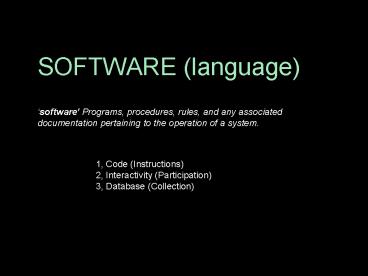SOFTWARE language - PowerPoint PPT Presentation
1 / 41
Title:
SOFTWARE language
Description:
software' Programs, procedures, rules, and any associated documentation ... (c) tame (d) suck[l]ing pigs (e) sirens (f) fabulous (g) stray dogs ... – PowerPoint PPT presentation
Number of Views:33
Avg rating:3.0/5.0
Title: SOFTWARE language
1
SOFTWARE (language)
software Programs, procedures, rules, and any
associated documentation pertaining to the
operation of a system.
1, Code (Instructions) 2, Interactivity
(Participation) 3, Database (Collection)
2
Software Project Assignment
Software Reading Assignment
3
Code (Instruction)
- Instructions
- Algorithmic or Generative Art
- (An algorithm is a procedure for solving a
problem)
4
How to Make a Dadaist Poem (method of Tristan
Tzara), (1920), Tristan Tzara (1896-1963)
- To make a Dadaist poem
- Take a newspaper.
- Take a pair of scissors.
- Choose an article as long as you are planning to
make your poem. - Cut out the article.
- Then cut out each of the words that make up this
article and put them in a bag. - Shake it gently.
- Then take out the scraps one after the other in
the order in which they left the bag. - Copy conscientiously.
- The poem will be like you.
- And here are you a writer, infinitely original
and endowed with a sensibility that is charming
though beyond the understanding of the vulgar.
5
Composition 1960 10, La Monte Young (1960)
"Draw a straight line and follow it."
6
Yoko Ono, Instruction Art
7
John Cage (1912-199 2), Cartridge Music 1960 and
Variations 1 1958
David Tudor (1926 -1996) preparing to perform
Cages Cartridge Music
Performance of variations 5
8
Glue Society, Gallery of the Living Dead (2008)
9
Learning To Love You More
10
Radical Software Group, HOW TO WIN "SUPER MARIO
BROS (2004)
11
Sol LeWitt, Wall Drawing 146 (1972)
All two-part combinations of blue arcs from
corners and sides and blue straight, not
straight, and broken lines.
12
Software Structures, Casey Reas et al. (2004)
13
Turux/Dextro (1995-2003)
14
Interactivity (Participation)
Reciprocal process of information exchange
between two or more players - humans, computers
etc.
- Different degrees of interactivity.
- The environment/software dictates the choices
the user/audience can make.
15
Lynn Hershman Lorna (1979-83)and Deep Contact
(1984-89)
16
David Rokeby Very Nervous System (1986-1990)
17
David Rokeby Very Nervous System
(1986-1990)softVNS
18
Jim Campbell, Shadow (For Heisenberg) ( 1993-94)
19
Scott Snibbe, Boundary Functions (1998)
20
Scott Snibbe, Boundary Functions (1998)
21
Scott Snibbe, Boundary Functions (1998)
Part of a dragonfly's wing
Gravitational influence of stars
The distribution of McDonald's Restaurants in San
Francisco.
(inspiration)
22
Scott Snibbe, Boundary Functions (1998)
(installation setup)
23
Scott Snibbe, Shy (2003)
24
Bernie Lubell, Conservation of Intimacy (2005)
25
Bernie Lubell, Conservation of Intimacy (2005)
26
Database (Collection)
- Categorization
- Interface/Data
27
Olaus Wormius (1588-1654) Cabinet of Curiosity
28
Cabinet of Curiosity at UCSB Museum of Art
(Current)
29
Karsten Bott, One of Each (1998) Found objects
and wooden boardwalk
30
Portia Munson, Pink Project, 1994
31
Portia Munson, Green Piece, 2000
32
Categorization
Categorization is the process in which ideas
and objects are recognized, differentiated and
understood. Categorization implies that objects
are grouped into categories, usually for some
specific purpose. Objects can be categorized
and organized in many different ways
- According to some property of the object,
- such as color, age, name, association.
- According to something external to the object,
- chance, when it was found etc.
33
Celestial Emporium of Benevolent Knowledge's
Taxonomy from Jorge Luis Borges (1899-1986),
"The Analytical Language of John Wilkins (1942)
Animals are divided into (a) belonging to the
Emperor (b) embalmed (c) tame (d) suckling
pigs (e) sirens (f) fabulous (g) stray dogs (h)
included in the present classification (i)
frenzied (j) innumerable (k) drawn with a very
fine camel-hair brush (1) et cetera (m) having
just broken the water pitcher (n) that from a
long way off look like flies
34
Bernd and Hilla Becher, Typologies
(Black-and-white photographs each 40 x 30 cm)
Gas-holders (Germany, Belgium, France, Britain,
USA), (1966-93)
Water Towers, USA (1988)
Winding towers (Germany, Belgium, France),
(1965-98)
35
Jennifer and Kevin McCoy, Every Anvil (2001)
36
Jennifer and Kevin McCoy, Every Anvil (2001)
37
Jennifer and Kevin McCoy, How I Learned (2002)
Examples of categories from How I Learned are
how I learned about ceremonies," how I learned
about blocking punches," how I learned about
exploiting workers," and how I learned to love
the land."
38
Jennifer and Kevin McCoy, How I Learned (2002)
Examples of categories from How I Learned are
how I learned about ceremonies," how I learned
about blocking punches," how I learned about
exploiting workers," and how I learned to love
the land."
39
Narrative Database
Lev Manovich Database As Symbolic Form
Syntagmatic Paradigmatic
40
We can look at the data in a database in
different ways because the data and its
representation are separated. We experience the
data/information through interfaces.
Different Interfaces to the UCSB Website
UCSB Website Homepage
UCSB Website Sitemap
Different Interfaces to the Flickr database
Flickr
Retrievr
41
INTERFACE
- An interface defines the communication boundary
between two entities, such as a piece of
software, a hardware device, or a user. It
generally refers to an abstraction that an entity
provides of itself to the outside. - An interface is the graphical or textual form of
interaction between user and software. Through
the interface the user may give commands to the
software which are then translated into
instructions that the computer can interpret.































